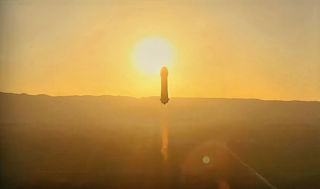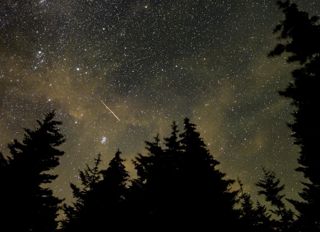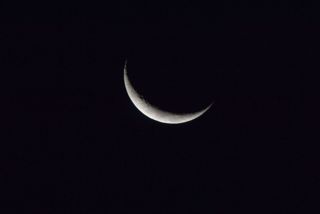
What's Happening in Space: August 2025
- 6th Aug 2025
- Author: Dhara Patel
A summary of space events through the month
Join Dhara Patel, National Space Centre Space Expert, for a whistle stop tour of some of the notable space and science events coming up in the weeks ahead...
Throughout August – spot the International Space Station
From Leicester, there may be sightings throughout the second half of August to spot the International Space Station (ISS) moving across the sky. Download NASA’s Spot the Station app using the App Store or Google Play to find out when and where to spot the largest artificial satellite overhead from your location. It’ll look like a bright star moving relatively quickly across the sky (generally from west to east) and will be visible to the naked eye.
Throughout August – Stargazing challenges / National Space Centre - Space NOW! podcast
Each month, the National Space Centre will be sharing a trio of stargazing challenges for everyone to have a go at. From spotting the Moon and familiar star patterns, to catching meteor showers and some deep sky objects. Check out the Stargazing Challenges - August 2025 blog for more details.
And NSC will also be going beyond the headlines unpacking some of the current space news stories in our podcast, so tune into Space NOW! to listen to new and previous episodes, or watch on YouTube

3rd August – New Shepard | NS-34 launch
NS-34 was the the fourteenth crewed sub-orbital spaceflight mission, operated by Blue Origin. The crew launched on a New Shepard rocket from Launch Site One in West Texas. The crew included Arvi Bahal, Gökhan Erdem, Deborah Martorell, Lionel Pitchford, J.D. Russell, and H.E. Justin Sun, the winning bidder for the first New Shepard seat in 2021, who was unable to attend that flight due to a scheduling conflict. J.D. Russell was flying for the second time; he previously flew on NS-28. Successfully launched at 12:43 (UK time) on 3 August, the NS-34 crew flew to just above the Kármán line at 100km altitude – considered the boundary of space. The reusable booster and crew capsule flying the passengers was to operate autonomously without the need for pilots. The flight lasted about 11 minutes (launch to landing) and during that time, the crew experienced around four minutes of weightlessness along with panoramic views of Earth's curvature and the blackness of space above.
9th August – full moon (8:54)
Known as the Sturgeon moon (according to the old Farmers’ Almanac), this month’s full moon is named by North American fishing tribes who realised the sturgeon fish were abundant in this month. Check out the Full Moon: Full Facts blog written by Mike Darch in the NSC Education team to find out more.
12th August – Venus and Jupiter close in the sky
Try looking for the two brightest naked eye planets, Venus and Jupiter, sat together in the eastern sky on the morning of 12 August. They will be in conjunction (sharing the same right ascension – coordinate) shortly after sunrise and will make a close approach around the same time – though they’ll be drowned out by daylight then, so instead catch the pair just before sunrise, around 4:00. Jupiter will sit just above Venus and the pair will be visible to the naked eye. Try to find clear views without tall buildings and trees to help you spot them at they’ll be close to the horizon. Find out more about close approaches and conjunctions in our astronomical phenomena blog written by David Southworth in the NSC Education Team.
12th August – Moon and Saturn close in the sky
Look for the waning gibbous moon near Saturn either during the early morning of 12 August in the southwest or after sunset in the eastern sky. The Moon will be in conjunction (sharing the same right ascension – coordinate) with Saturn in the late afternoon, but the pair will be below the horizon so the best opportunities to see them close together is before sunrise earlier that day or in the late evening around 22:00 after sunset on 12 August. The Moon will appear to the right of Saturn if spotted before dawn and to the left of the ringed planet at dusk. Saturn will appear as a point of light visible to the naked eye. In the evening, they’ll be close to the horizon, so clear views without tall buildings and trees will help you spot them more easily. If you fancy a challenge and have a telescope to hand, you might also be able to spot Neptune sitting close to Saturn too. Check out the astronomical phenomena blog linked above to find out more about close approaches and conjunctions.

12th/13th August – peak of the Perseid meteor shower
The Perseids is one of the best annual meteor showers, with ~ 100 meteors per hour at its peak and is produced by dust left behind by Comet Swift-Tuttle. The shower peaks on the evening of 12 August into the early morning of 13 August. With the moon in its waning gibbous phase, it will be up throughout the night so moonlight will drown out the fainter meteors – as such, it’s worth viewing from as dark a location as possible. The radiant (the point in the sky in the constellation of Pereus where the meteors will appear to radiate from) will appear in the north-east rising higher into the sky as the night unfolds. Find an open location with clear views of the horizon and face north-east but scan the entire starry canvas above, as meteors can appear anywhere in the sky. Check out the Perseid Meteor Shower 2025 blog to find out more.
19th August – Mercury at greatest western elongation
Because Mercury orbits closer to the Sun than Earth, it always appears quite close to the Sun in the sky being lost in its glare most of the time. However, Mercury will be at its furthest separation from the Sun on 19 August when it reaches greatest western elongation, making it a great time to try and spot the Sun’s closest planet, which should be visible to the naked eye. Look to the northeast just before the Sun rises – it will be very close to the horizon, so you’ll need a good clear view without tall buildings and trees. Check out the astronomical phenomena blog linked above to find out more about greatest elongations.
20th August – Moon and Jupiter close in the sky
The extremely thin waning crescent moon will be observable beside Jupiter during the early morning of 20 August before sunrise in the eastern sky. The Moon will be in conjunction (sharing the same right ascension – coordinate) with Jupiter during the late evening of the previous day (19 August) and will also be in close approach around the same time, but both will be below the horizon then. So, the best time to spot the duo close together will be a short while before sunrise, around 4:00 on 20 August. The Moon will be positioned to the left of Jupiter, and you might also spot Venus further below the Moon. They’ll be visible to the naked eye, but you will need clear views without tall buildings and trees to help you spot them easily. Check out the astronomical phenomena blog linked above to find out more about close approaches and conjunctions.

20th August – Moon and Venus close in the sky
Venus will be in conjunction (sharing the same right ascension – coordinate) with the waning crescent moon just before midday on 20 August but it will be drowned out by daylight at this time. So, look for Venus close to the Moon in the east during the hours before sunrise instead. You’ll be able to spot Jupiter close by too (as shared above) since it’ll be the best time to spot Jupiter near the moon as well. Venus will appear like a bright star and the Moon will sit almost directly above. They’ll be visible to the naked eye, but clear views without tall buildings and trees will help you spot them more easily especially as they’ll be low on the horizon. Check out the astronomical phenomena blog linked above to find out more about close approaches and conjunctions.
23rd August - new moon (7:06)
The new moon will occur in the constellation of Leo. The lack of moonlight interference provides a great time to try and view deep sky objects (especially with the aid of binoculars and telescopes). We have a blog on Moon phases written by Mike Darch in our Education team. Being the third out of four new moons between the June summer solstice and the September equinox (astronomical season of summer), this new moon is known as a black moon!
26th August – Moon and Mars close in the sky
Look for Mars positioned beside the Moon during the evening of 26 August in the western sky. The waxing crescent moon will be in conjunction (sharing the same right ascension – coordinate) with Mars in the daytime, so the skies won’t be dark enough to spot the pair. Try and look for them in close proximity a short while later as the sun begins to set and the sky begins to darken – but don’t wait too long as they’ll begin to set around 20:30. And since the pair will be close to the horizon, clear views without tall buildings and trees is essential to help you observe them. They will be visible to the naked eye - Mars will appear as a red point of light sitting slightly further up and to the right of the Moon. Check out the astronomical phenomena blog linked above to find out more about close approaches and conjunctions.
August?? – Starship flight 10
Starship is made up of the Super Heavy booster – a first stage rocket with 33 of SpaceX’s raptor engines, and on top of that sits the upper stage - rather confusingly also called Starship (which hosts 6 engines). And when its fully developed, this launch vehicle will be a completely reusable rocket – both first and second stages. A modified version of Starship is also currently planned to land astronauts on the Moon with the Artemis 3 mission. Starship is due to launch on its tenth test flight in August (date tbc) from SpaceX’s launch facility, Starbase in Boca Chica, Texas, United States.
The flight profile isn’t yet certain but is expected to be alike to the previous three flights – a suborbital flight of a new, upgraded version of the upper stage of the rocket – the Block 2 Starship vehicle, with the current Block 1 Super Heavy booster vehicle underneath. During the last three flights, there were several failures which led to explosions/early termination of the vehicle, so test flight 10 will hope to improve on the outcomes of these previous flights. Find out more about Starship and SpaceX’s other rocketry achievements in our SpaceX – the world’s rocket giant blog by Ed Kellond-Turner in our Education team.
Please note: As this summary is created at the end of the month before, dates (especially launch dates) can often change or be updated, so this content may become outdated - we always recommend checking on the relevant organisation's pages.
